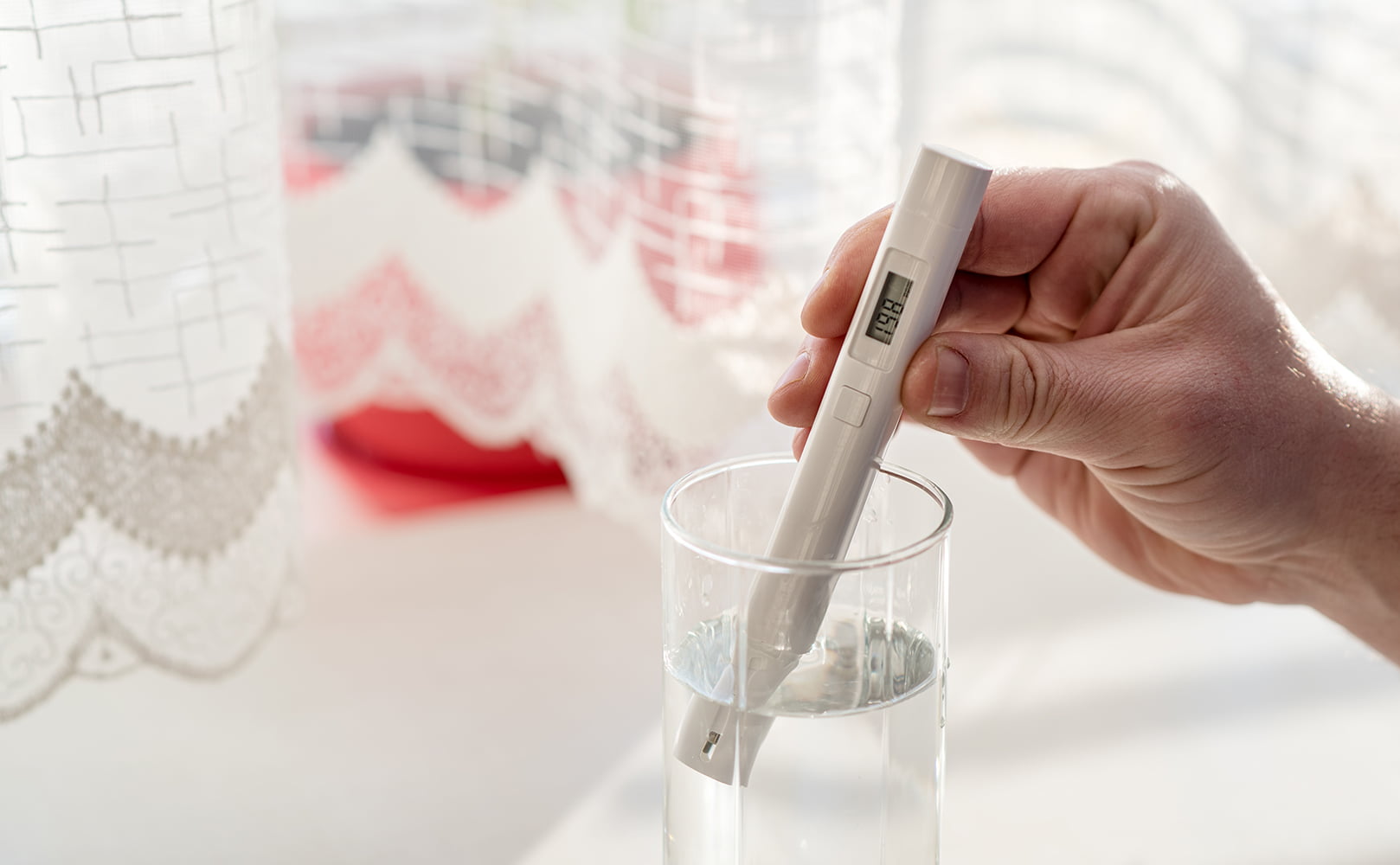How to Check TDS of RO Water
Written by: Gene Fitzgerald // Last Updated: Aug 7, 2023
This page may contain affiliate links. If you buy a product or service through such a link we earn a commission at no extra cost to you. Learn more.
You can measure the TDS (total dissolved solids) of your reverse osmosis water in several ways.
Some are more involved than others, and it is essential to note that they only measure the total dissolved solids and will not tell you exactly what those solids are.
Let’s review each method to see which is right for you!
Key Takeaways
- Measuring the TDS of your RO water can be done using a digital TDS meter, an electrical conductivity meter, or filter paper and a scale.
- Using a digital TDS meter is the simplest method.
How to Check TDS of RO Water
So, how to check TDS levels of RO water?
Checking the TDS of your RO water can be done using a few different methods. The basic premise is to measure your RO water and your feed water and then compare the two following these steps:
- Measure the TDS of the unfiltered feed water.
- Measure the TDS of the filtered RO water.
- Substitute these values into the following formula: Rejection rate % = (TDS of Unfiltered Water – TDS of RO Water) / Unfiltered Water TDS x 100
Method 1: Using a Digital TDS Meter
A TDS meter is an electronic device that indirectly measures TDS levels in water by measuring electrical conductivity.
How does it work? The meter applies an electrical current in the water in order to measure conductivity. The TDS meter then converts that value of electrical conductivity into a corresponding TDS level using a conversion factor. In other words, while conductivity is indeed measured, the conversion into TDS is just an estimate. Because different solids dissolved in water cause different levels of electrical conductivity. So the “true” TDS level of your reverse osmosis water might be slightly higher or slightly lower.
By the way, a reading of TDS in parts per million (ppm) or milligrams per liter (mg/L) are essentially the same.
And again, it’s important to note that although TDS meters give pretty accurate TDS level readings, they do not provide information about the specific substances present in the water.
This method is the simplest way to check for water TDS, as it gives instant results and does not require complicated mathematical equations!
You can use the TDS meter as follows:
- Remove the TDS meter’s protective cap and turn it on.
- Submerge the TDS meter in the sample water to the indicated level. Do not immerse it more than indicated, as water may enter the meter.
- If air bubbles are in the water, gently stir the digital meter to remove them.
- Allow 10-15 seconds for the actual TDS concentration reading to be recorded.
- Once you have measured the TDS reading of the water, shake off any excess water from the digital meter and replace the protective cap.
Method 2: Measuring Electrical Conductivity
This technique also applies an electrical current to the water and measures the level of resistance that the TDS will cause. The more dissolved minerals in the water, the more electricity will be conducted.
You will need a sample of the water and an electrical conductivity meter.
- Place the water sample on a flat surface, switch on the conductivity meter and insert it into the water.
- Allow some time for the reading to stabilize, as at the beginning, it may fluctuate.
- Calculate TDS using the formula: TDS (mg/l) = KE * EC (KE = Co-relation Factor; EC= Conductivity)
Method 3: Using Filter Paper + Scale
To measure TDS using filter paper and a scale takes a bit more work! You will need a clean glass container, filter paper, a clean evaporating dish, a stirring stick, a pipette, and a digital scale.
- Begin by weighing the evaporating dish and noting down the measurements.
- Thoroughly stir the water sample to ensure an even distribution of dissolved solids.
- Using the pipette, extract a 50 ml sample from the stirred water and carefully pour it through the filter paper into the container. Repeat this process at least three times to ensure complete absorption of dissolved solids by the filter paper.
- Transfer the filter paper to the evaporating dish.
- Weigh the evaporating dish with the extracted filtrate and record the measurement.
- To calculate the TDS, use the formula: TDS = (A-B) *1000 / water sample taken in mL ( A is the weight of the evaporating dish and filtrate, and B is the weight of the evaporating dish alone).
What Is TDS in Reverse Osmosis Water Anyway?
TDS stands for total dissolved solids and indicates the level of dissolved substances in water. It encompasses both harmful contaminants and beneficial minerals like magnesium and calcium.
RO systems excel at eliminating TDS from water, with a remarkable reduction of 95-99% after passing water through a reverse osmosis membrane. By measuring the TDS level in your feed water and comparing it to the TDS of your output RO water, you can assess the efficiency of your RO system without professional water testing.
Total dissolved solids encompass a range of matter, both organic and inorganic. These substances include heavy metals, minerals, salts, pesticides, water disinfectants, and more.
Contact with rock formations is the primary cause of total dissolved solids in drinking water. When rock formations, limestone or salt deposits come into contact with water, they can raise the levels of total dissolved solids by introducing calcium, magnesium, carbonate, sodium, etc. While these dissolved solids do not pose any significant harm, they can affect the taste of the water.
More worrisome origins of TDS include exposure to sewage, agricultural runoff, storm overflow, industrial and chemical discharge, and pipe leaching.
The most common TDS found in water are:
- Arsenic
- Iron
- Sodium
- Fluoride
- Chlorine
- Bicarbonates
- Sulfates
- Pesticides
- Herbicides
- Bromide
Why It’s Important to Check TDS Levels in RO Water
The measurement of TDS is valuable in assessing the RO filtration process’s efficacy. A properly working reverse osmosis system should achieve a significant reduction in TDS, typically in the range of 90% or more.
If, after testing, there is a drop in the TDS reduction rate, it could indicate that your RO membrane is not functioning effectively anymore and needs replacing.
Ideal Drinking Water TDS Levels
RO systems typically remove around 90% of TDS from the feed water. Even with an optimally functioning system, some TDS remain in the RO water. Typically, RO water contains a TDS of 10 to 50 ppm, although this may vary. This range is ideal as it ensures the removal of nearly all dissolved (and potentially harmful) particles. However, the TDS level recommended for the best tasting drinking water is 150 ppm.
As for levels considered a danger to human health, the EPA states water with a TDS level of 500 ppm is suitable, while anything exceeding 1,000 ppm is classified as potentially hazardous. The WHO says that water with a TDS level above 1,200 is considered dangerous.
If you have any questions about how to check RO water TDS please don’t hesitate to leave a comment below!
Information provided on BOS is for educational purposes only. The products and services we review may not be right for your individual circumstances.
We adhere to strict editorial guidelines. Rest assured, the opinions expressed have not been provided, reviewed, or otherwise endorsed by our partners – they are unbiased, independent, and the author’s alone. Our licensed experts fact-check all content for accuracy. It is accurate as of the date posted and to the best of our knowledge.



